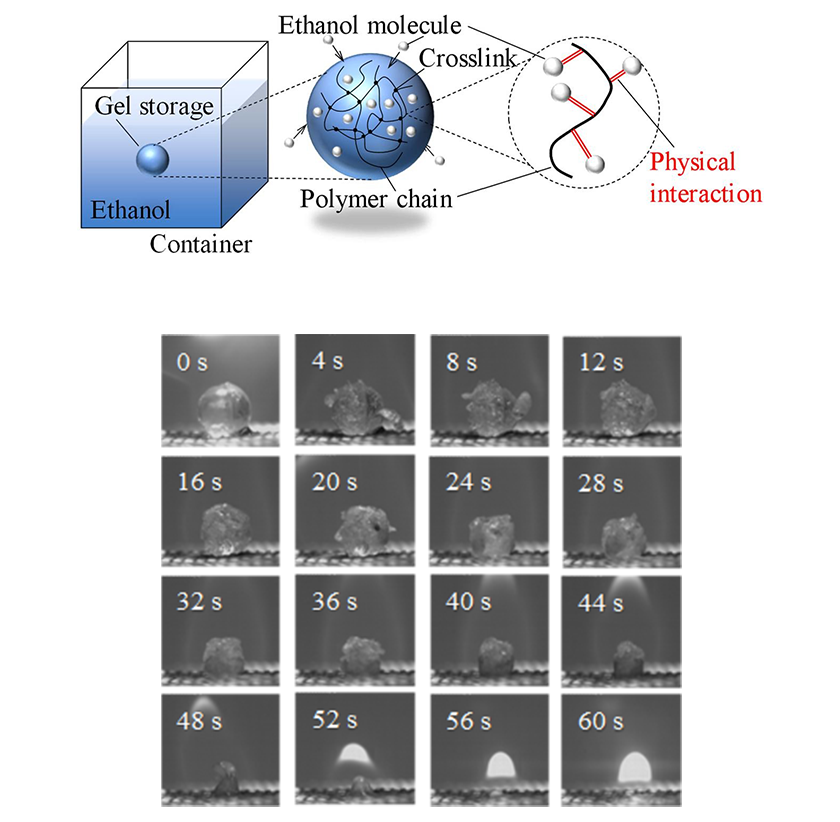Despite their widespread use, liquid fuels with high energy density are hazardous to transport and store due to their volatility, which generates explosive gas mixtures.
 Storage of ethanol inside a polymeric gel sphere (top) and the combustion state of the polymeric gel storage (bottom). Researchers from SIT Japan showed in a new study that chemically cross-linked polymeric gel networks can trap highly volatile liquid fuel molecules, such as ethanol, through physical interactions, thereby greatly reducing their evaporation rate and risks of fire accidents. Image Credit: Naoki Hosoya, Shibaura Institute of Technology, Japan.
Storage of ethanol inside a polymeric gel sphere (top) and the combustion state of the polymeric gel storage (bottom). Researchers from SIT Japan showed in a new study that chemically cross-linked polymeric gel networks can trap highly volatile liquid fuel molecules, such as ethanol, through physical interactions, thereby greatly reducing their evaporation rate and risks of fire accidents. Image Credit: Naoki Hosoya, Shibaura Institute of Technology, Japan.
Scientists from Japan’s Shibaura Institute of Technology and Tokyo Institute of Technology explored the feasibility of storing liquid fuel within polymeric gel networks, restricting rapid evaporation and demonstrating good combustion performance, to address this problem. Their research makes room for safer liquid fuel transportation and storage.
Numerous applications where chemical energy is transformed into controlled motion, such as rockets, boilers, gas turbines, and certain vehicle engines, require liquid fuels with high energy density. Apart from their combustion characteristics and performance, it is indeed critical to ensure the safety and stability of these fuels while in use, as well as during transport and storage.
When dealing with liquid fuels, one common risk is that they can evaporate quickly if given enough space, resulting in clouds of highly flammable gases. This can result in devastating explosions or fires.
To address this issue, scientists have considered using gelled fuels, which are fuels that have been frozen into thick gel-like substances. Apparently, many aspects must be optimized and obstacles must be resolved before gelled fuels can progress beyond the research stage.
A team of scientists headed by Professor Naoki Hosoya of Shibaura Institute of Technology (SIT) and Professor Shingo Maeda of Tokyo Institute of Technology (Tokyo Tech) explored a more compelling solution to the safety problem of liquid fuels: storing them inside polymeric gel networks.
The researchers looked at the performance, benefits and drawbacks of storing ethanol, a common liquid fuel, inside a chemically cross-linked poly(N-isopropylacrylamide) (PNIPPAm) gel. The study was published on September 15th, 2022, in the Chemical Engineering Journal.
They first looked to see if trapping ethanol molecules inside the long and chemically intertwined PNIPAAm polymer chains could help reduce the rate of evaporation. The investigators put small spheres of PNIPAAm gel filled with ethanol on an electronic scale to see how the mass altered as the ethanol vaporized. They also carried out the experiment with a puddle of ethanol that had a similar surface area and mass to the gel sphere.
They discovered that storing ethanol in a polymer gel entirely removed the fuel’s tendency to vaporize quickly. This is most likely due to the “trapping” of ethanol molecules in the gel.
The polymeric gel contains innumerable three-dimensional polymer chains that are chemically cross-linked in a strong way. These chains bind the ethanol molecules through various physical interactions, limiting its evaporation in the process.
Naoki Hosoya, Professor, Shibaura Institute of Technology
The loaded gel, however, does not behave like a wet towel. The polymeric gel did not easily release ethanol under external forces, unlike a wet towel that would release its liquid if wrung.
The team then looked at the actual combustion characteristics of the ethanol in the polymeric gel network to see if it burned efficiently after solving the evaporation problem. They lit ethanol-filled gel spheres of various sizes and watched the mass and shape profiles change in real-time. They concluded that the burning of the loaded PNIPAAm gel spheres was divided into two phases: one dominated by pure ethanol burning, and the other dominated by the burning of the PNIPAAm polymer itself.
The team came to an important conclusion after conducting a theoretical analysis of these findings: the first and primary combustion phase of the loaded PNIPAAm gel spheres pursues a constant droplet temperature model, also recognized as the “d2law.” This means that the ethanol-loaded gel can be explained using the same model as liquid fuel droplets, implying that their combustion characteristics are similar.
On the whole, this research paves the way for new ways to transport and store liquid fuels securely inside polymer gels, potentially saving many lives.
Polymeric gel storage could prevent explosions and fire accidents by drastically reducing the evaporation of fuels and, in turn, the formation of flammable gaseous mixtures, which can readily happen following a leak in a storage facility.
Naoki Hosoya, Professor, Shibaura Institute of Technology
Hosoya adds, “Much work still remains to be done on this front, such as checking the stability and performance of polymeric gels at different temperature, pressure, and humidity conditions, as well as developing simpler fabrication procedures and better ways to use these fuel-loaded gels in real engines.”
Journal Reference:
Hosoya, N., et al. (2022) Chemically cross-linked gel storage for fuel to realize evaporation suppression. Chemical Engineering Journal. doi.org/10.1016/j.cej.2022.136506.